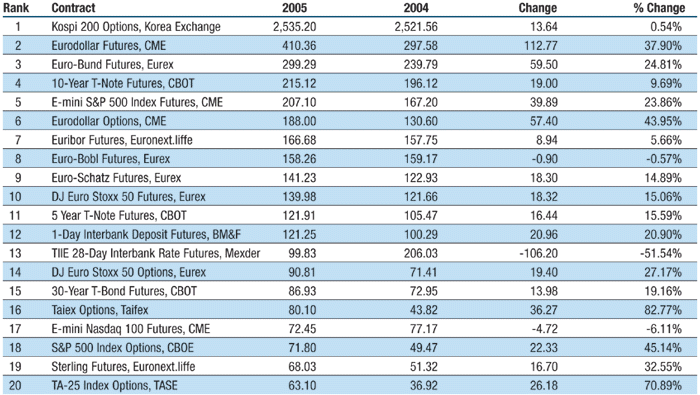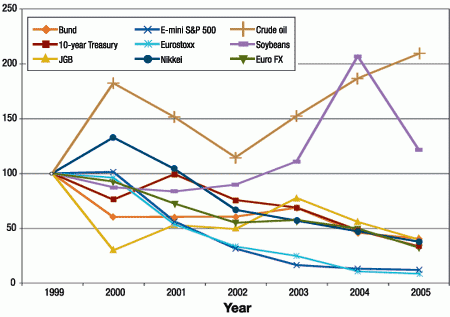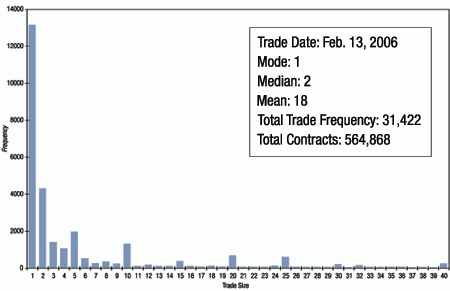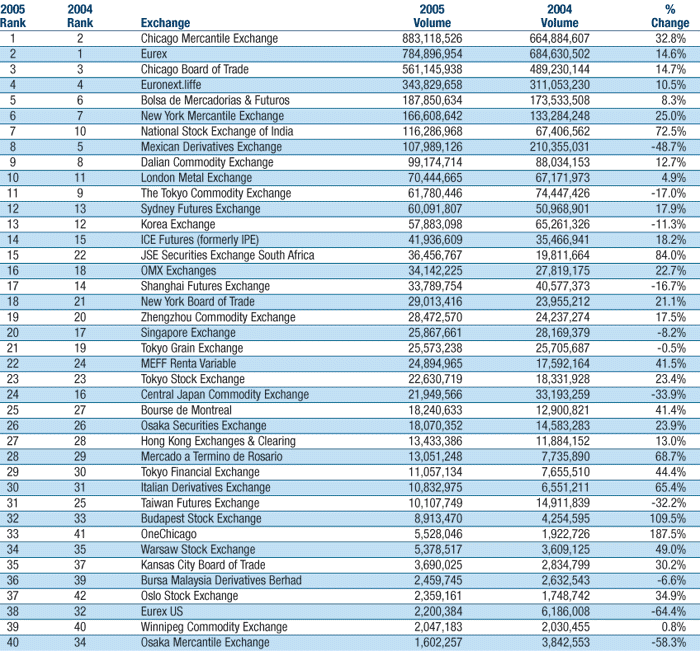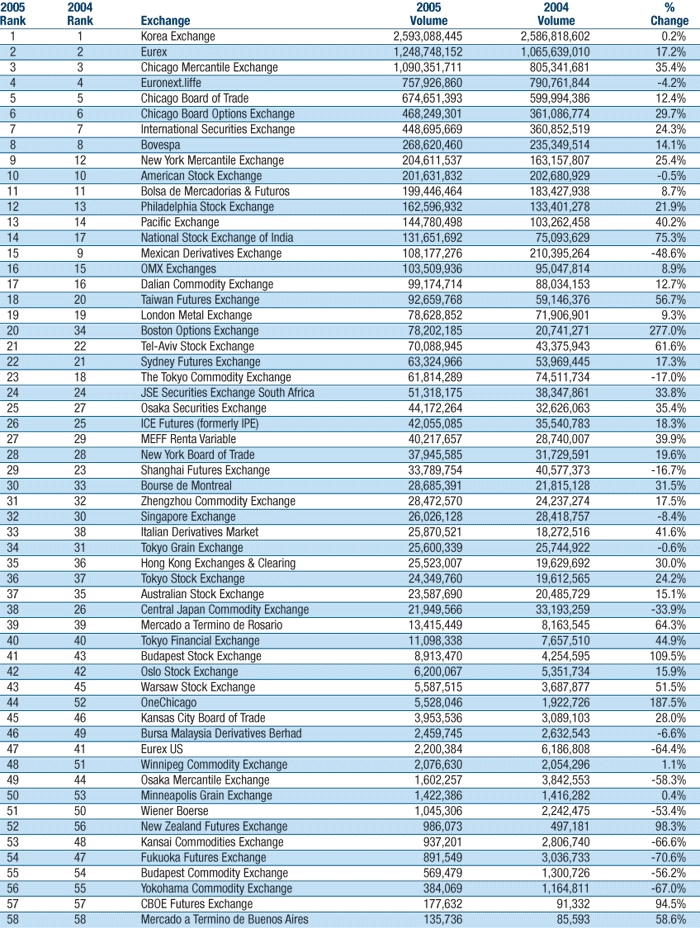It seems fitting to pause at the mid-point of the decade to reflect on what has happened. It’s been a remarkable period for the futures and options business. At year-end 1999, as we entered the new millennium, volume on U.S. futures exchanges had fallen 7%. But thanks to an 11% increase on non-U.S. exchanges, global volume actually rose 10% that year to 2.4 billion contracts traded. Just six years later, global volume stands an astonishing 312% higher at 9.9 billion contracts traded.
What is responsible for all of this growth? Although we’re seeing price discovery and risk management happening all over the world—China, India, Brazil, Taiwan—the number of exchanges hasn’t grown. While new exchanges have been added to the list, an almost equal number have dropped off, mostly due to consolidation. FIA tracks 58 exchanges today versus 59 in 1999.
What has grown is the amount of business exchanges are doing, particularly the top five exchanges. As we have been writing for years in this space, electronic trading is having a major impact on volume (more on that later). Liquidity providers, no longer physically constrained by a trading pit, can (and do) trade markets all over the world. Smaller contracts are being traded in big numbers. Five of the top 20 contracts offer small contract sizes. New exchanges coming on the list, like the International Securities Exchange, are trading significantly more than the exchanges they replaced. And big players and small have gotten over their 1990s fascination with the stock market and have turned to futures and options in search of respectable returns and more efficient ways to trade.
To a large extent, the growth story over the last six years has to do with the success of the top five exchanges. In 1999, the top five (Eurex, Chicago Board of Trade, Chicago Board Options Exchange, Chicago Mercantile Exchange, and Monep) accounted for 53% of the futures and options trading done globally. At year-end 2005, the top five exchanges (Korea Exchange, Eurex, CME, Euronext, CBOT) accounted for 64% of world volume. Eurex held the top spot going in 1999 and 2000. Korea Stock Exchange entered the top five for the first time in 2000 as a result of a 142% increase in trading in its Kospi 200 options contract. KSE took over the top spot in 2001 and has remained there since. Eurex has held on to its number two spot since being unseated by Korea. CBOT fell from the second place position in 1999 to fifth place today. CME beat the CBOT for third place in 2001 and has held firmly to that spot for the last three years.
Predecessors of today’s Euronext group participated in the top five list all six years. Monep, which became part of Paris Bourse, was in fifth place in 1999; Paris Bourse was in third and fourth place in 2000 and 2001 respectively. Euronext appeared first on the list in 2002 in the number three spot which it held onto in 2003 before dropping to fourth place in 2004 and 2005. The CBOE bounced from third place in 1999 to number two in 2000, number four in 2001 and has held steady in sixth place for the last three years.
Of the top five exchanges today, Korea has seen by far the largest volume growth, advancing 2570% from 97.1 million contracts traded in 1999 to 2.59 billion contracts traded in 2005. The other exchanges also experienced exceptional growth: Eurex, up 230%; CME, up 443%; and CBOT, up 165%. Euronext was up 156% if the consolidation of Paris, Belfox, Amsterdam, Lisbon and Liffe is considered.
Notable newcomers have included the International Securities Exchange, which was added in 2001 and is currently in seventh place with 448.7 million contracts traded. Also new to the list are the Bovespa, Mexican Derivatives Exchange, National Stock Exchange of India, Dalian Commodity Exchange, and Boston Options Exchange, all of which rank in the top 20.
Equally interesting is a comparison of the list of top 10 futures and options contracts traded in 1999 versus 2005. Six of the contracts on the top 10 list in 1999 are still on the list today: Kospi 200 options, and Eurodollar, Euro-Bund, 10-year T-note, Euribor and Euro-Bobl futures. In 1999, the top 10 list also included U.S. T-Bond futures and options (T-bond futures are currently in 15th place and options are 61st), Cac 40 Index options (currently in 33rd place), and crude oil (now in 21st place). These contracts have been replaced by E-mini S&P 500 index futures, Eurodollar options, Euro- Schatz futures and DJ Euro Stoxx 50 futures.
Which brings us to 2005.
U.S. Exchanges Soar
One of the most astonishing things about this past year is the huge growth of futures and options trading in the U.S. where futures trading was up 25% while options trading was up 27%. In contrast, trading outside the U.S. was up 6% in futures and 4% in options. Part of the surprise comes from the fact that much of the industry’s growth in recent years has come from the spread of futures and options trading to new parts of the globe. Brazil, India, Mexico, and China are homes to four of the world’s 10 largest futures exchanges. And part of the surprise comes from the fact that volatilities in interest rate and stock markets generally fell last year.
The impetus for this growth stems from two continuing developments. One is the ongoing effect of electronic trading on the cost of trading futures. The other is the growth of hedge funds and the role they play in trading stock options.
The Top 20 Contracts
Futures and options on broadly defined underlying commodities or indexes cannot help but dominate futures or options on individual securities. Among the top 20 we find the Kospi 200 options hanging out in a world of their own. At 2.5 billion traded, it sounds a lot like McDonald’s in an earlier age. Volume reached a high of 2.8 billion in 2003 and fell 11% in 2004. The downward trend appears to have ended in 2005 with a .54% uptick.
The next 10 contracts represent U.S. and European interest rate and equity markets. You find Eurodollar futures and options (two and six respectively), 10-year and 5-year Treasury note futures (four and 11 respectively), Euro-Bunds, Bobls, and Schatz futures (three, eight, and nine respectively), E-mini S&P futures (5) and DJ Euro Stoxx futures (10). The next nine contracts represents a mix of interest rate and stock index contracts from Brazil, Mexico, Taiwan, Israel, the U.K. and the U.S.
The Role that Money Managers Play
Money managers are attracted to returns and the possibility of diversification, and exchange-traded futures and options are perfect vehicles for trading. In addition to commodity trading advisors, two groups that have been a major force in our markets have been hedge funds and long-only commodity funds. Both groups have attracted large amounts of money, and each has had a major influence on our markets.
Hedge funds trade cover a lot of ground, but a lot of what they do includes long/short equity strategies that employ a lot of stock options. This may be the main reason why, in a mature market and in the face of declining volatility, the market for individual equity options has continued to grow in the U.S. the way it has. Last year, contract volume at the Chicago Board Options Exchange (up 29.7%), the International Securities Exchange (up 24.3%), the Philadelphia Stock Exchange (up 21.9%) and the Pacific Exchange (up 40.2%) increased far more than one would have expected. At the same time hedge fund assets under management grew from $795 billion in 2004 to $934 billion in 2005, an increase of 17%.
In recent years, commodity markets (i.e., non-financial markets) have afforded high returns and have attracted a lot of investors and money to long-only commodity funds. According to recent “street” estimates, there might be as much as $90 billion invested in these funds, which include those tied to the GSCI and the Dow Jones AIG indexes. This was a huge increase from the roughly $55 billion invested in these funds in 2004.
This would go a long way to explaining the record levels of open interest that these markets have experienced.
A Note on Open Interest
We rarely spend much time talking about open interest in our annual review of volume statistics. The open interest numbers FIA collects are a snapshot of open contracts on the last day of the month. It is worth noting, however, that at the end of 2005, open interest was up dramatically (114%) in the U.S. futures markets. It was up more modestly (36%) when futures, options on futures and options are combined and up only 10% on non-U.S. markets.
What does this mean? High open interest figures typically represent commercial, institutional and even retail interest in the market—traders who hold positions longer than their professional trading counterparts. If that is true, then 2006 is off to a very good start.
The Evolution of Futures Trading Costs
I was taught by the best that the reason futures have been successful tools for trading and hedging is that they are both cheaper to trade and have superior credit qualities than either their cash market or over-the-counter equivalents. This insight has been a great help over the years in understanding why futures trading has grown the way it has. And I think the insight is still helpful, although the equipment we need to understanding trading costs is more sophisticated than it used to be.
Transactions costs typically include a measure of the bid/ask spread, which can be measured in any number of ways. The liquidity of a market might be characterized, for example, by the spread between the best bid and the best offer. This should work well for small trades. For larger trades, one might dig deeper into the limit order book and find out what it would cost to sweep the book to fill orders and compare the average cost per contract to sell the order and the average cost per contract to buy the order.
As a general rule, the effective bid/ask spread for a trade of any given size will be proportional to a ratio that includes a measure of price volatility in the numerator and of trading velocity (e.g., average daily trading volume) in the denominator. The form of this ratio would be:
Bid/ask spread for trade size N = k x price volatility / square root of volume
where k captures things like the risk aversion of market makers and some mathematical constants.
The ratio makes intuitive sense at a basic level. The more volatile the price of the commodity, the more a market maker (the liquidity provider) will require to take your position from you. On the other hand, the faster the flow of trading through the market, the more quickly the market maker can unload the position and the lower his risk. (The presence of the square root in the ratio will seem natural to options traders who are comfortable with the relationship between price volatility and the square root of time.
Now consider what has happened to the liquidity of various futures markets over the past few years. Using this ratio, we calculated the indexed values of a theoretical bid/ask spread for orders of a given size for nine futures contracts. We set the initial 1999 value for each series equal to 100.
The results are striking on a number of fronts. All of the financial contracts, which are traded electronically, have become substantially more liquid. By 2005, the implied bid/ask spreads for Eurobunds, 10-year Treasury notes, JGBs, the Nikkei, and the Euro were all about 40% of what they were in 1999. And the implied spreads for the E-mini S&P and the Eurostoxx contracts were less than 10% of what they were in 1999. These are astonishing improvements.
In contrast, crude oil and soybeans, both of which are pit-traded contracts, have become less liquid over the same period. The implied bid/ask spread for soybeans in 2005 was about 25% higher than it was in 1999, while the implied spread for crude oil contracts was more than double what it used to be.
Just where these observations fit in the realm of science is hard to know, but these results are consistent with the well-worn hypothesis (or saw) that liquidity breeds liquidity. As contracts become cheaper to trade, the more they will be traded, and the cheaper they will become to trade.
The Contribution of Algorithmic Execution
A more subtle aspect of trading costs involves the replacement of human brokers, order fillers, and pit traders with computers. Human time is expensive. Human error is a fact of life. Computer time, in contrast, is cheap. And computer errors, once programs have been stabilized and “fat fingers” have been brought under control, are relatively few. Consider four ways in which the use of computers can reduce the cost of trading.
Reduced market impact—One practical consequence of allowing computers to execute trades is that it becomes economically more practical to divide trades into smaller lot sizes than is possible with human agents. This may not seem like much until one includes market impact in the cost of trading. One of the best ways to reduce market impact is to spread a trade out over time. For those traders with comparatively durable trading signals, this is a plus. And it is apparent that the market is taking advantage of this feature of electronic trading.
Consider the histogram that shows the distribution of trade size in E-mini S&Ps on a recent trading day. While the average trade size was 18 contracts, the most common trade size was a one-lot, and nearly half of all trades executed involved two contracts or less. This does not mean that the market is a retail market. Instead, it means that large orders are filled with a large number of small lots.
I see no reason why a market like this might not one day be dominated completely by one-lots. For one thing, the economics of futures transactions do not penalize this approach to trading. For another, the reduction in market impact that a trader can achieve actually works in favor of this approach.
Reduced errors—Electronic trading markets are by no means free of error. At the same time, approaches to trading that require quick reads on the depth of the market, reactions to prices or fills in other markets, or that involve a lot of markets at the same time can tax the capacity of humans to read, interpret, and respond.
Discipline and objectivity—An interesting challenge that algorithmic execution poses for a trader is the need to write down, in computer code, what the trader wants the computer to do. This is easy right up to the point where you start doing it. At that time, you have to be very particular about what it is you think you’ve been doing in your trading life. You have to find measures of liquidity that can be quantified, rules for working orders that can be quantified, rules for reacting to unexpected volume or price shocks, and rules for executing stops. In my own experience, traders can find this an insurmountable hurdle.
But for those who are willing to commit their trading rules to paper, the upside is a hugely valuable tool for evaluating trading results. One can measure objectively what was done and what the results were. And with trades that can be done frequently, the trader can accumulate a data set that allows him to evaluate trades with dispassion and objectivity.
Providing liquidity—One cost of trading can be “giving up the edge” to the market or the market maker by lifting offers or hitting bids. In a world organized around physical trading pits, it is highly impractical for someone off the floor to act as a market maker— that is, to work bids and offers. In an electronic world, however, a trader can devise trading rules that can save some of this cost by allowing him to be part of the market making system. Anyone with enough patience and a reasonable tolerance for risk can be a market maker. In turn, this ability not only reduces the trader’s costs, it reduces trading costs for others by increasing the supply of liquidity in the market.
Rebirth of Currency Futures
Further evidence of the role that electronic and algorithmic execution is playing in the growth of our industry comes from the extraordinary growth of currency futures. For most of my time in the industry, currency futures have lost both in market share and outright volume. Last year, though, currency futures trading was up 57%. Total contract volume is still relatively small (160 million) and is probably still a very small fraction of the world’s currency trading, but the growth is encouraging.
Worth Noting
Tucked down at the bottom of the Agriculturals, Energies, and Metals table is a line item called Other. Other is a catchall category that comprises trading in things like weather and plastics. Total contract volume is minute, but it is huge in outright romance.
What makes this exciting to someone like me is that this category represents the extension of the futures and options concepts to completely new types of products. For example, Rich Sandor and his Chicago Climate Exchange are creating a market for emissions by creating tradeable property rights where none seemed to exist before. This is inspired work by one of the greatest innovators in the industry, and is exactly the kind of thing that adds life and leaven in trading world that may have become inured to the joys that futures and options have brought to the world of applied finance.
|
|
|
|
|
|
|
|




